Fractured Priorities
USA Gets a D in Infrastructure

kodama cc
Civil Engineers Deliver the Bad News
Michael Collins
"The overall grade for the nation’s infrastructure is again a D and the cost to bring it up to good condition has risen to $2.2 trillion. In more than a decade, the United States has made no measurable progress in improving either the condition or performance of our roads, bridges, water systems or other vital infrastructure when viewed in aggregate."
American Society of Civil Engineers, 2009 Report Card on U.S. Infrastructure
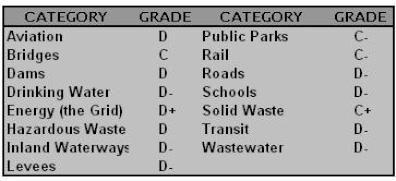
Read it and weep. This the nation's infrastructure report card from the American Society of Civil Engineers. We're not doing too well. Maybe our fearless leaders of the last 40 years forgot their glasses or got into some of that Indian Hemp that George Washington talked about. Without any doubt, they were not paying attention to the fundamentals.
While Wall Street gangsters raided the Treasury and Bush-Cheney invested over a trillion dollars in destroying then "rebuilding" Iraq, the bridges, levees, power grid, and other vital elements of the United States infrastructure moved to a point of near collapse.
The Obama stimulus package contains $300 plus billion to start this repair process. This is the first comprehensive program for infrastructure since the mid 1950's and a down payment on the $2.2 trillion required for the entire project.
Here's what we face according to the association representing engineers who will get the job done.
Welcome to the future -- if we fail to act
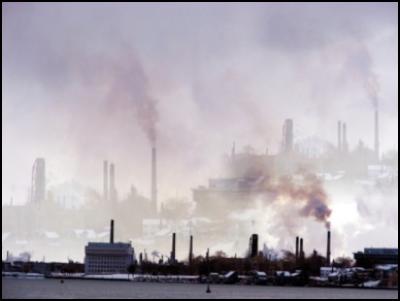
Port Huron, Michigan offers a glimpse of the future if we fail to act on the
vial repairs to the infrastructure of the United States. mdprovost cc
Rush hour collapse in Minneapolis, Aug. 1, 2007
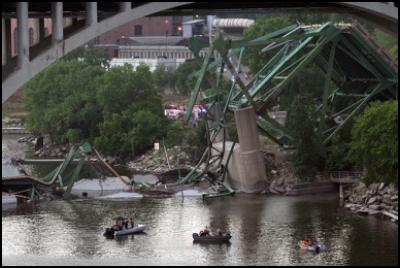
The I-35 West Bridge collapsed in rush hour on August 1, 2007.
Rescuers rushed to the scene. Poppyseed Bandit cc
This Minneapolis bridge collapsed at rush hour. Thirteen died, over 100 were injured, and the city was stunned. The National Transportation Safety Board found that poor design and neglectful maintenance were the culprits in the easily avoidable tragedy.
"More than 26%, or one in four, of the nation's bridges are either structurally deficient or functionally obsolete. While some progress has been made in recent years to reduce the number of deficient and obsolete bridges in rural areas, the number in urban areas is rising. A $17 billion annual investment is needed to substantially improve current bridge conditions. Currently, only $10.5 billion is spent annually on the construction and maintenance of bridges." ACSE
Here today, gone soon. A likely dam collapse.
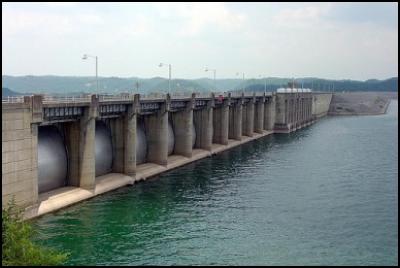
Wolf Creek Dam, near Manntown, Kentucky jenniferrt66 cc
This dam tops the list of "most likely to collapse soon." The Wolf Creek Dam borders southern Kentucky and Northern Tennessee. Its design virtually guarantees a collapse. The response: "We estimated a range somewhere between about 50 and 120 people, the loss of life -- people who live downstream, and possibly fishermen or campers that may be down there," (the Army Corps of Engineers) tells CBS
The Senators from Kentucky must think that neglect will somehow save this structure.
"As dam's age and downstream development increases, the number of deficient dams has risen to more than 4,000, including 1,819 high hazard potential dams. Over the past six years, for every deficient, high hazard potential dam repaired, nearly two more were declared deficient. There are more than 85,000 dams in the U.S., and the average age is just over 51 years old." ACSE
Not enough
roads, too many cars and the "Metro" is
empty
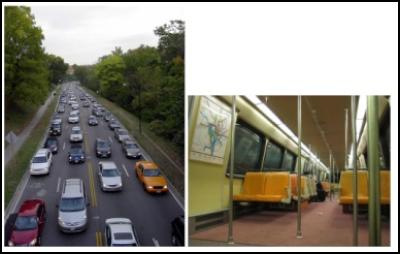
Washington, DC area traffic can be a nightmare even on a "parkway." With the traffic at stand still for hours a day, the Metro trains rarely get a chance to do their job and relieve the congestion. Images - Left, haddensavix cc, Right Danny McL cc
How long does it take you to get to work? In the Washington, DC area, it can take 90 minute to go 20 miles at rush hour. The high way system is, in essence, a slightly mobile parking lot. This jacks up pollution, drains fuel efficiency, and frustrates a lot of people. The DC areas is not alone. New York City, Los Angeles, Houston, Miami, and Atlanta are all competing for the worst traffic in the Western hemisphere.
"Americans spend 4.2 billion hours a year stuck in traffic at a cost to the economy of $78.2 billion, or $710 per motorist. Poor road conditions cost motorists $67 billion a year in repairs and operating costs, and cost 14,000 Americans their lives. One-third of America's major roads are in poor or mediocre condition and 36% of major urban highways are congested. The current spending level of $70.3 billion per year for highway capital improvements is well below the estimated $186 billion needed annually to substantially improve the nation's highways." ACSE
Levees are in bad shape, but nobody knows just how bad.
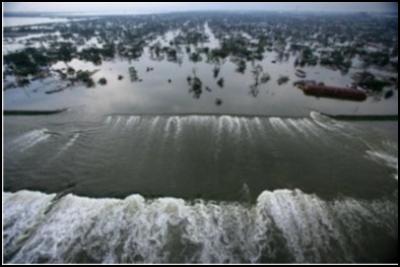
"When the Levee Breaks" Greg
Here's what Katrina did to New Orleans levees. They've had trouble repairing levees even with all the money provided. A wall of water is just a major storm away for many areas across the nation.
"More than 85% of the nation's estimated 100,000 miles of levees are locally owned and maintained. The reliability of many of these levees is unknown. Many are over 50 years old and were originally built to protect crops from flooding. With an increase in development behind these levees, the risk to public health and safety from failure has increased.' ACSE
Schools are in tatters in some places.
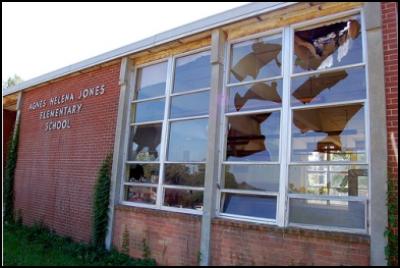
A lost school in rural Virginia. taberandrew cc
"Spending on the nation's schools grew from $17 billion in 1998 to a peak of $29 billion in 2004. However, by 2007 spending fell to $20.28 billion. No comprehensive, authoritative nationwide data on the condition of America's school buildings has been collected in a decade. The National Education Association's best estimate to bring the nation's schools into good repair is $322 billion." ACSE
That's a steep price but what's the alternative? The do-nothing cult used to say, go back to the "three Rs" -- reading, writing, and 'rithmetic. Since the tech revolution, they can no longer use that homage to a time that never existed, so they complain bitterly about spending but offer nothing as an alternative.
Can you see … LA today?
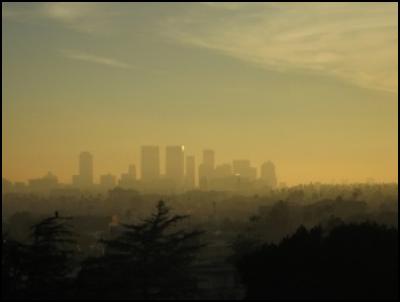
Los Angeles Wes & Eli cc
Probably not, although it's still beautiful on a clear day. In addition to the home grown pollution generated by automobiles, pollution has gone nationwide. Smoke stacks in one state lift the toxins up and the wind does the rest. Note the unhealthy pines in the foreground.
Multi state pollution generator on an ineffective power grid
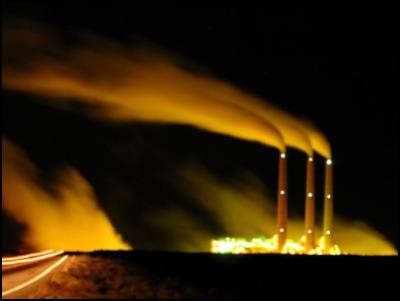
The Navajo Reservations power plant is scenic but toxic as well.
Is this what "clean coal" looks like? bass nroll cc
"Demand for electricity has grown by 25% since 1990. Public and government opposition and difficulty in the permitting processes are restricting much needed modernization. Projected electric utility investment needs could be as much as $1.5 trillion by 2030." ACSE
We all require power and the power plants available are filthy. "Clean coal" is a myth. Not enough people in the power structure are looking to the sun or checking how strongly the wind blows across the country. Outmoded power infects every aspect of the deterioration of infrastructure. The plant above is now under EPA review for air pollution.
What if we don't fix things?
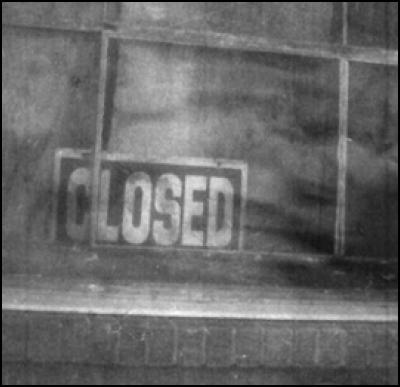
mharford cc
The roads, levees, power grid, damns and other key elements of our infrastructure will soon reach a point of absolute tolerance. After that point, serious economic contraction will set in. Inter state trade on a regional basis may become the preferred option due to the hazards of just getting around the country. State and regional conflict over water and power will emerge pitting the "haves" against the "have nots." Imagine a trade war between the Great Lakes states and the South over access to fresh water. The notion of "United" will be threatened by irresolvable conflicts between "States." The results of a cycle of continual shortage and competition for ever scarcer resources may become irreversible.
The dialog on the stimulus plan, the first step to avoid a bleak future, is already polluted. Opponents cited a fictitious Congressional Budget Office study and claimed there would be major delay in spending. But facts were never their strong point.
The forces of denial and failure may have lost an election but they're alive due to the Wall Street welfare program for their loyal patrons. Like sharks in a feeding frenzy, the Republicans were in lock step unity in opposing the rebuilding effort. Their alternative -- do nothing!
It is all so unnecessary, given some foresight and commitment. But as long as the cult of ignorance and mandated suffering persists in its superstitious quest, we risk entering the perfect storm of no planning, no regulation, and no action. The future of the country is still in the balance.
Permission to reproduce in whole or in
part with attribution of authorship, a link to this article,
and acknowledgement of images as
indicated.


 Binoy Kampmark: The Strawman Of Antisemitism - Banning Protests Against Israel Down Under
Binoy Kampmark: The Strawman Of Antisemitism - Banning Protests Against Israel Down Under Gordon Campbell: On The Coalition’s Empty Gestures, And Abortion Refusal As The New Slavery
Gordon Campbell: On The Coalition’s Empty Gestures, And Abortion Refusal As The New Slavery Keith Rankin: Judaism, Antisemitism, And Israel
Keith Rankin: Judaism, Antisemitism, And Israel Ian Powell: Haka, Hikoi And The Empowerment Of The Kohanga Generation
Ian Powell: Haka, Hikoi And The Empowerment Of The Kohanga Generation Binoy Kampmark: Feeding Chaos - Israel Cripples Syria’s Defence
Binoy Kampmark: Feeding Chaos - Israel Cripples Syria’s Defence The Conversation: News Bargaining Incentive:
The Conversation: News Bargaining Incentive: